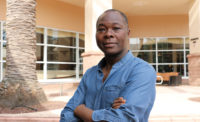Frank Lloyd wright once said that it is “just as desirable to build a chicken house as to build a cathedral.” Filmmaker Michael Miner took that to heart but, instead, built an unrealized doghouse of Wright’s design. Miner now wants to rebuild another forgotten FLW work—this time, a pavilion in Banff, Alberta. The building, a low-slung rustic timber structure with a cantilevered roof and art glass windows, was completed in 1914 and served as a gathering point for tourists visiting the national park. Due to extreme winters and flooding, the building deteriorated and was demolished 25 years after it opened. A sports field now occupies the site. Miner hopes, through grassroots fundraising by his nonprofit, the Frank Lloyd Wright Revival Initiative, to give the reconstructed pavilion back to the town. The reconstruction, which Miner estimates will cost $2.2 million Canadian dollars, has won preliminary support from the town council and is the subject of a feasibility study. RECORD spoke with Miner about the project.
Architectural Record: How did you first fall in love with FLW’s work?
Michael Miner: Ironically, I had a girlfriend who was very much into Frank Lloyd Wright when we dated.
At least something good came out of the relationship.
Yeah, something, exactly. I had the opportunity, after that particular relationship broke up, to take a three-year road trip, and I got to visit many of Wright’s buildings. I was so taken by the experience, I did a series of Wright films.
Why did you establish the Frank Lloyd Wright Revival Initiative?
As I experienced Wright’s buildings and saw some restoration efforts, I thought there was a better way to do it. We evaluated all the buildings that had been demolished and decided which would be relatively easy to build and relatively inexpensive. In 2013, I visited Banff with my wife and dog, and we approached the town council about resurrecting the Pavilion.
Have you had naysayers?
Of course, even when I posted on my organization’s Facebook page, we had a couple of people who were like, “So are you going to call them Wright-inspired buildings?” I said, “No—this is not a cheap imitation. We are using Wright’s plans, except with modifications that are inescapable because of modern building codes.
So you have the original plans?
We do. These plans are in the archives of Canada and Ottawa. We have all of the working drawings and all of the specifications. I was talking to Eric Lloyd Wright [FLW’s grandson], and said if we want to do this exactly as Wright intended, we have to have a horse and cart for 75 cents an hour to get the wood to the site.
What was your pitch to the town?
My initial pitch was that it would be good for tourism, and it would right a historical wrong. I talked to the town planner in 2013 and it went nowhere, but earlier this year I got a call from the Canadian press because the town had a new redevelopment plan.
Have you enlisted an architect?
We have not. Right now, we’re fundraising, and the next thing will be a call for architects. We want a lead Canadian architect for both the politics and for the practicality. Ironically, this is what FLW did then—he was not licensed to practice in Canada, so his Canadian student, Francis C. Sullivan, was his architect of record.
And the Revival Initiative would fund the project?
I have no intention of taking any government money from America or Canada whatsoever. I don’t like the idea of begging for money—I like the idea of everyone having a stake in it and feeling like they are part of it.








Post a comment to this article
Report Abusive Comment